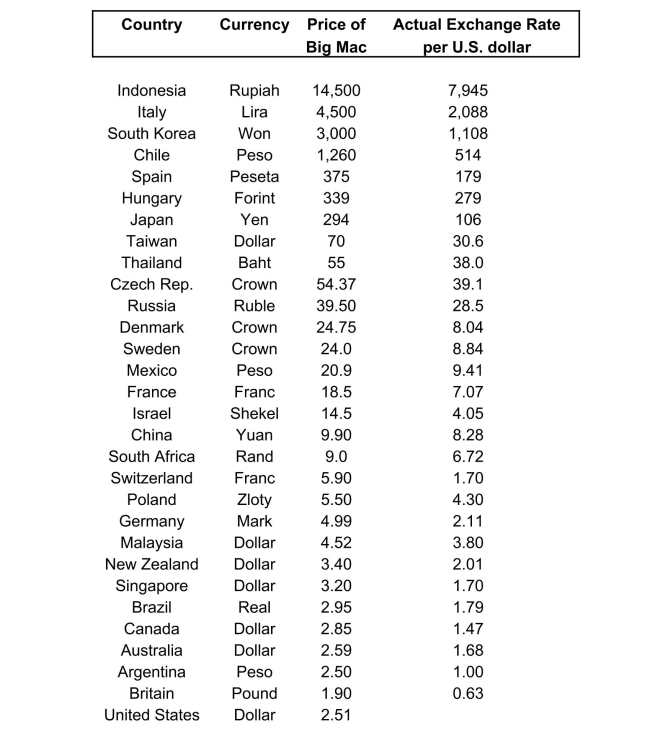(continuation with the Purchasing Power Parity question from Chapter 4)
The news-magazine The Economist regularly publishes data on the so called Big
Mac index and exchange rates between countries.The data for 30 countries from
the April 29, 2000 issue is listed below:  The concept of purchasing power parity or PPP ("the idea that similar foreign and domestic goods ... should have the same price in terms of the same currency," Abel, A. and B. Bernanke, Macroeconomics, edition, Boston: Addison Wesley, 476) suggests that the ratio of the Big Mac priced in the local currency to the U.S. dollar price should equal the exchange rate between the two countries. 16
The concept of purchasing power parity or PPP ("the idea that similar foreign and domestic goods ... should have the same price in terms of the same currency," Abel, A. and B. Bernanke, Macroeconomics, edition, Boston: Addison Wesley, 476) suggests that the ratio of the Big Mac priced in the local currency to the U.S. dollar price should equal the exchange rate between the two countries. 16
After entering the data into your spread sheet program, you calculate the predicted
exchange rate per U.S.dollar by dividing the price of a Big Mac in local currency
by the U.S.price of a Big Mac ($2.51).To test for PPP, you regress the actual
exchange rate on the predicted exchange rate.
The estimated regression is as follows: (a)Your spreadsheet program does not allow you to calculate heteroskedasticity
robust standard errors.Instead, the numbers in parenthesis are homoskedasticity
only standard errors.State the two null hypothesis under which PPP holds.Should
you use a one-tailed or two-tailed alternative hypothesis?
Definitions:
Spreading Alternatives
The act of diversifying choices or options in decision-making or behavior.
Free Choice Paradigm
A laboratory situation in which people make a choice between two alternatives, and after they do, attraction to the alternatives is assessed.
Dissonance Reduction
Involves efforts or strategies to alleviate the discomfort caused by holding two or more conflicting cognitions, such as beliefs, attitudes, or behaviors.
Cognitive Dissonance
A psychological phenomenon involving discomfort felt by an individual when they hold conflicting beliefs, ideas, or values at the same time.
Q3: When the estimated slope coefficient in
Q5: Given that the following statement is incorrect,
Q7: (Requires Calculus) In the multiple regression
Q16: <span class="ql-formula" data-value="\text { Consider the standard
Q23: (Requires material from Section 11.3
Q34: Let <span class="ql-formula" data-value="R _
Q35: In the linear regression model,
Q37: Prove that <br> <span class="ql-formula" data-value="F
Q43: Consider the following two models involving
Q44: In the case of a simple